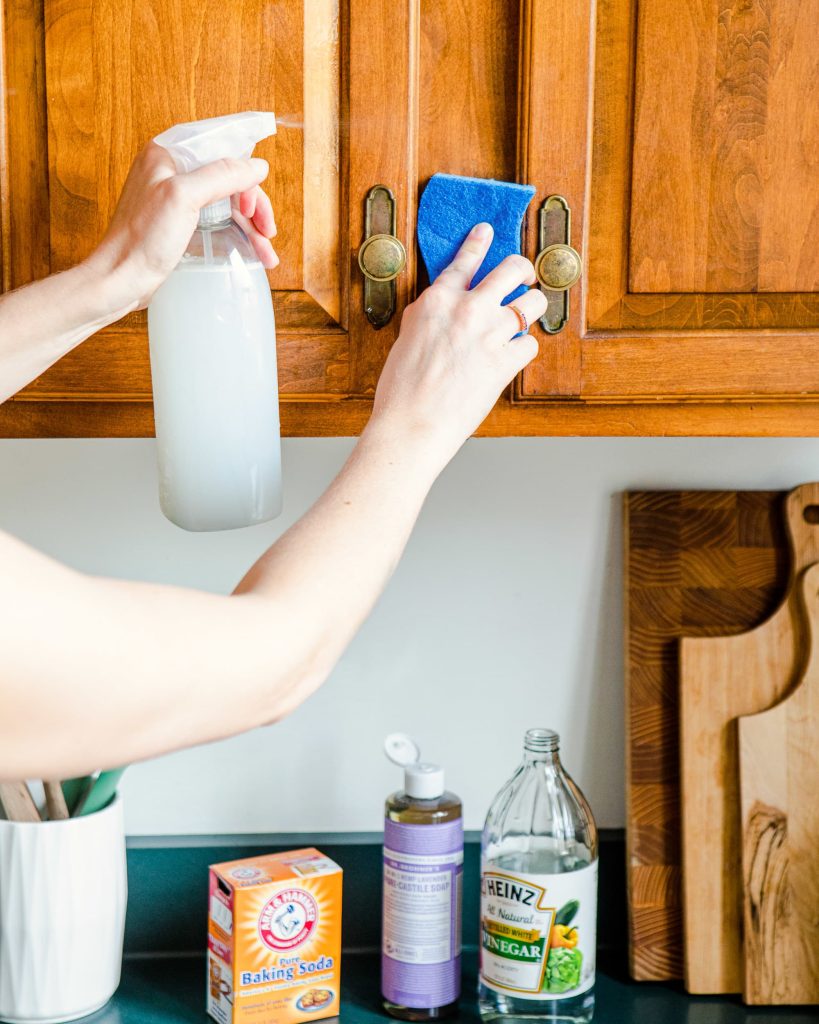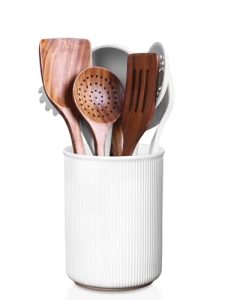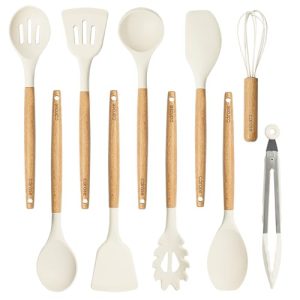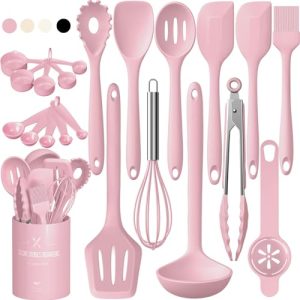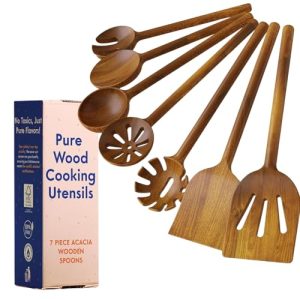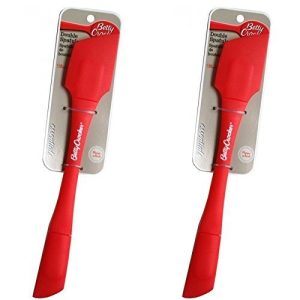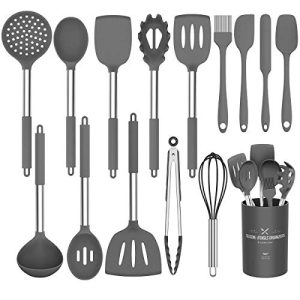Are your kitchen cabinets looking dull and sticky from layers of grease and grime? You’re not alone.
Many of us struggle with keeping our kitchen cabinets clean, especially with the constant cooking and splattering. But what if there was a solution that made the task easier and more effective? Imagine opening your cabinets to find surfaces that are sparkling clean and free from that stubborn greasy residue.
You’d feel a sense of satisfaction every time you step into your kitchen, wouldn’t you? We’re going to reveal the best cleaner for greasy kitchen cabinets that can transform your kitchen space effortlessly. Stay with us to discover the secret to achieving that pristine, fresh look you’ve been longing for in your kitchen.

Credit: mypinterventures.com
Importance Of Choosing The Right Cleaner
Choosing the right cleaner for greasy kitchen cabinets is crucial. It ensures your cabinets remain spotless and durable. Not all cleaners are created equal. Some might damage the finish, while others may not be effective. Using the wrong cleaner can also leave residues. This can attract more dirt and grime. Thus, selecting a suitable cleaner is essential for maintaining your kitchen’s beauty.
Why The Right Cleaner Matters
The right cleaner protects your cabinet’s surface. This prevents long-term damage. A good cleaner effectively removes grease. It does so without leaving harmful residues. This ensures your cabinets maintain their natural shine. The wrong cleaner can strip the finish. This may lead to costly repairs or replacements.
Potential Risks Of Using The Wrong Cleaner
Using an unsuitable cleaner poses risks. It can cause discoloration and damage. Some cleaners contain harsh chemicals. These chemicals can erode the cabinet’s surface. This weakens the material over time. It might also leave a sticky residue. This attracts more grease and dirt. Regular use of the wrong cleaner can ruin your cabinets.
Considerations For Selecting The Best Cleaner
Consider your cabinet material first. Different materials need different cleaners. Check the cleaner’s ingredients. Look for mild, non-abrasive formulas. Ensure the cleaner is suitable for kitchen use. It should be effective on grease. A good cleaner will remove dirt without harsh chemicals. This keeps your cabinets safe and clean.
Factors To Consider
Selecting the best cleaner for greasy kitchen cabinets involves considering its effectiveness and safety. Check if the cleaner is non-toxic and suitable for your cabinet material. Also, consider ease of use and residue-free formulas for a hassle-free experience.
Factors to consider when choosing the best cleaner for greasy kitchen cabinets are crucial. These factors ensure that your cabinets remain spotless without damage. Understanding these elements will guide you in selecting the right product.Effectiveness Against Grease
Grease builds up quickly in busy kitchens. Select a cleaner that tackles stubborn grease stains effectively. Look for products that dissolve grease with minimal scrubbing. Fast-acting formulas save time and effort. Ensure the cleaner leaves no sticky residue behind.Safety For Cabinet Material
Cabinet materials vary greatly. Wood, laminate, and metal each require special care. Choose a cleaner designed for your cabinet’s specific material. Avoid harsh chemicals that might strip finishes or cause discoloration. Test the cleaner on a small area first to ensure it won’t damage your cabinets.Environmental Impact
Environmental safety is important. Opt for eco-friendly cleaners with biodegradable ingredients. These products minimize harm to the ecosystem. Check for certifications that verify the cleaner’s environmental claims. Green products often use natural ingredients, reducing health risks.Types Of Cleaners
Greasy kitchen cabinets can be a real headache. Choosing the right cleaner makes the task easier. Several options exist, catering to different preferences and needs. Let’s explore the types of cleaners available for greasy kitchen cabinets.
Natural Solutions
Natural cleaners offer a gentle approach. Vinegar and baking soda work well for many. Vinegar cuts through grease effectively. Baking soda adds a scrubbing power. Lemon juice is another option. It not only cleans but also leaves a fresh scent. These solutions are eco-friendly and often found in most homes.
Commercial Products
Commercial cleaners provide a convenient solution. They are designed specifically for kitchen grease. Look for products labeled as degreasers. Many brands offer powerful formulas. These cleaners require less scrubbing effort. Ensure the product is safe for your cabinet material. Always read the label for directions and precautions.
Diy Options
DIY cleaners are cost-effective and customizable. You can mix ingredients based on your needs. A popular recipe includes vinegar and water. Add a few drops of dish soap for extra cleaning power. Another option is combining baking soda with water. Create a paste and apply to stubborn spots. These homemade solutions let you control the strength and scent.

Credit: www.youtube.com
Top Picks For Greasy Cabinets
Discover the best cleaner for greasy kitchen cabinets to effortlessly tackle stubborn stains. Explore top picks that effectively cut through grime while maintaining cabinet surfaces. Keep your kitchen fresh and clean with these powerful solutions designed for easy use and lasting results.
Are you tired of battling stubborn grease on your kitchen cabinets? You’re not alone. The quest for the best cleaner can feel overwhelming with so many products available. But don’t worry, we’ve narrowed down the top picks that can transform your greasy cabinets into spotless surfaces. Whether you’re a seasoned cook or just someone who loves a clean kitchen, these products are sure to impress.Product Reviews
Let’s dive into some of the top cleaners that have earned rave reviews. Krud Kutter Original Concentrated Cleaner/Degreaser is a favorite among many. Users love its powerful formula that cuts through grease effortlessly. Another popular choice is Murphy’s Oil Soap, which is gentle yet effective, leaving cabinets clean and smelling fresh. On the natural side, Baking Soda and Vinegar offers a DIY approach. This combination is perfect if you prefer a chemical-free solution. Method All-Purpose Cleaner is also a great eco-friendly option that doesn’t compromise on effectiveness.Pros And Cons
When choosing a cleaner, it’s important to weigh the pros and cons. Krud Kutter is highly effective but can be a bit harsh on sensitive skin. You might want to wear gloves when using it. Murphy’s Oil Soap is gentle and smells great, but might require a bit more elbow grease for very stubborn spots. If you’re patient, it’s a great option. Baking Soda and Vinegar is environmentally friendly and inexpensive, yet it can be a bit messy to apply. Are you willing to sacrifice convenience for a natural approach? Method All-Purpose Cleaner is kind to the environment and surfaces, though it may not tackle heavy grease as efficiently. Consider how much grease you’re dealing with before choosing. Every cleaner has its strengths and weaknesses. What’s most important is finding the one that aligns with your cleaning priorities. Do you prioritize effectiveness, eco-friendliness, or ease of use? Your answer can guide you to the perfect cleaner for your kitchen cabinets.Application Techniques
Cleaning greasy kitchen cabinets can be a daunting task. But, using the right application techniques makes it easier. Proper techniques ensure effective cleaning and prolong the cabinet’s lifespan. Let’s dive into the steps and methods for a spotless kitchen.
Preparation Steps
Start by clearing items from the cabinets. This avoids accidental spills or damage. Gather necessary materials like soft cloths, cleaning solutions, and gloves. Always check cleaner labels for safety instructions.
Test a small cabinet area with the cleaner. This prevents damage to the cabinet finish. Ensure good ventilation in the kitchen. Open windows and doors for fresh air.
Cleaning Methods
Apply the cleaner to a soft cloth. Avoid spraying directly on the cabinet surface. Wipe cabinets gently, focusing on greasy spots. Use circular motions for stubborn stains.
Rinse the cloth with water, then wipe again. This removes any cleaner residue. Repeat the process if needed. For deep stains, use a soft brush. Scrub gently to avoid scratches.
Maintenance Tips
Regularly clean cabinets to prevent grease buildup. Wipe them once a week with a damp cloth. Use mild cleaners for routine cleaning. Avoid harsh chemicals to preserve cabinet finish.
Protect cabinets from heat and steam. Use range hoods when cooking. Keep cabinets dry to prevent warping or discoloration.
Common Mistakes To Avoid
Choosing the wrong cleaner can damage your kitchen cabinets. Avoid using harsh chemicals that strip the finish. Also, don’t forget to test on a small area first to prevent surprises.
Cleaning greasy kitchen cabinets can be a daunting task, especially if you make common mistakes. The wrong approach can leave your cabinets looking worse and even cause damage. To ensure your cabinets sparkle without mishaps, it’s vital to know what pitfalls to avoid.1. Using The Wrong Cleaner
Many people choose the first cleaner they find. This is a mistake. Some cleaners contain harsh chemicals that can strip the finish from your cabinets. Always read labels and opt for a cleaner specifically designed for kitchen grease. Consider trying a small amount on an inconspicuous area first to see how it reacts.2. Scrubbing Too Hard
It might seem like more elbow grease means better cleaning, but that’s not always true. Scrubbing too hard can scratch or dull the surface of your cabinets. Instead, use a soft cloth or sponge and let the cleaner do the work. Apply gentle pressure and repeat if necessary.3. Skipping The Rinse
After applying a cleaner, it’s easy to forget to rinse it off. Leaving cleaner residue can attract more dirt and grease. Always follow up with a clean, damp cloth to wipe away any leftover product. This leaves your cabinets fresh and ready for the next meal prep.4. Ignoring The Handles And Hinges
Cabinet handles and hinges are magnets for grease, yet they’re often overlooked. Neglecting these areas can lead to a buildup that’s hard to remove. Make it a point to clean handles and hinges regularly. You might be surprised at how much grime collects there.5. Not Establishing A Cleaning Routine
One-time deep cleaning isn’t enough. Grease builds up quickly, so regular maintenance is key. Set a schedule to tackle cabinet cleaning, perhaps weekly or bi-weekly. This helps avoid overwhelming grease buildup and keeps your kitchen inviting. Have you been making these mistakes? Adjusting your approach can make a world of difference. Your cabinets can stay clean and beautiful with just a few simple changes. Remember, the right method saves time and preserves your kitchen’s charm.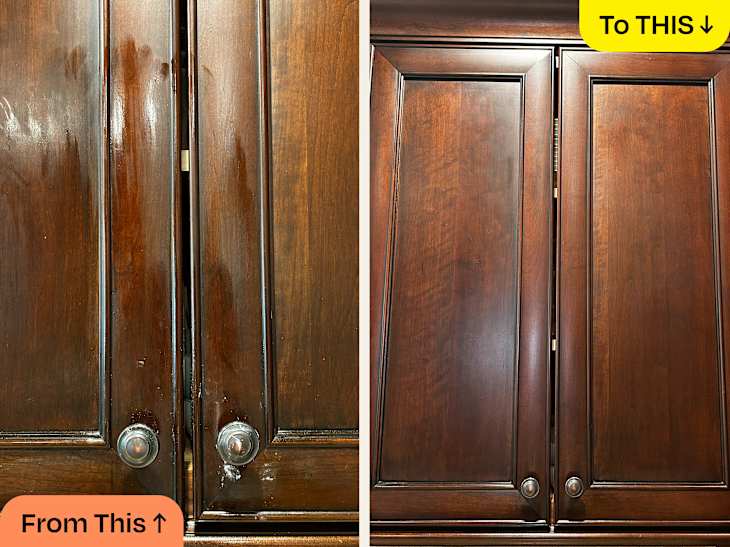
Credit: www.thekitchn.com
Frequently Asked Questions
How Do You Remove Greasy Residue From Kitchen Cabinets?
Mix equal parts vinegar and water in a spray bottle. Spray on cabinets and wipe with a microfiber cloth. For stubborn grease, use baking soda paste, gently scrub, and rinse. Dry thoroughly to prevent residue. Regular cleaning keeps cabinets free from grease buildup.
What Is The Best Cleaner To Degrease Wood Cabinets?
Use a mixture of vinegar and water to degrease wood cabinets. Add lemon juice for extra cleaning power. Baking soda can help remove stubborn grease. Always test on a small area first.
How Do You Clean Kitchen Cabinets Without Removing The Finish?
Use a mixture of warm water and mild dish soap. Gently scrub cabinets with a soft cloth or sponge. Rinse with clean water and dry thoroughly. Avoid using abrasive cleaners or pads to prevent damaging the finish. Regular cleaning maintains cabinet appearance and longevity.
Does Magic Eraser Work On Greasy Cabinets?
Magic Erasers effectively clean greasy cabinets. They remove stubborn grease with ease. Dampen the eraser slightly for best results. Always test on a hidden spot first to ensure no damage.
Conclusion
Choosing the right cleaner simplifies your kitchen tasks. Clean greasy cabinets efficiently. Always use gentle products to protect surfaces. Frequent cleaning prevents build-up and stains. A clean kitchen feels welcoming. Keep products handy for quick touch-ups. Safe cleaners protect both your health and the environment.
Experiment with different options to find the best fit. Remember, consistent cleaning maintains a fresh look. Enjoy cooking in a spotless kitchen. Your effort today makes tomorrow’s cleaning easier. Stay informed about new products and methods. A clean kitchen enhances your cooking experience.
Happy cleaning!
